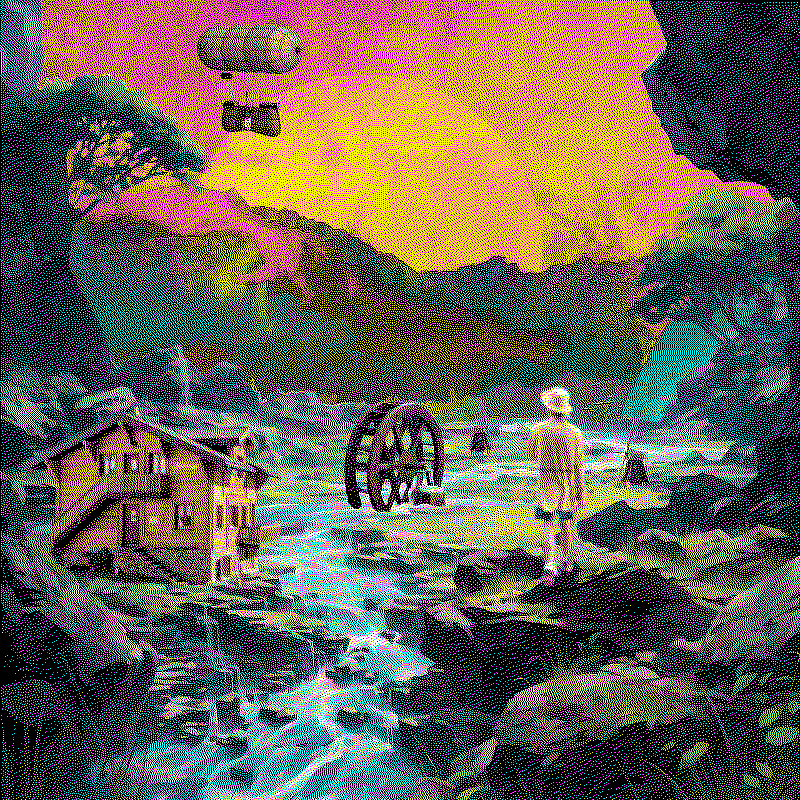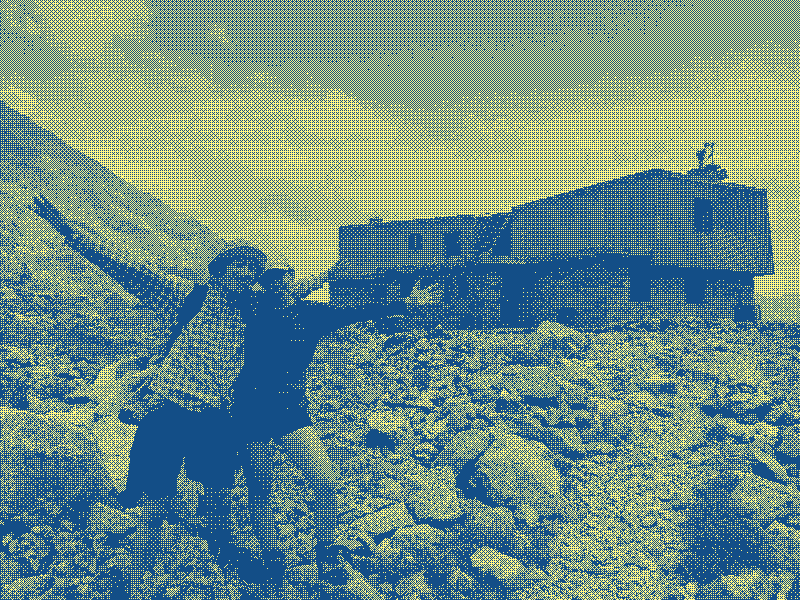[Article] Notre identité visuelle
2023/12/03 - Pourquoi nos images sont pixelisées ? On vous dévoile les coulisses de notre identité visuelle.

Introduction
In this article, we explain the thinking that led us to this fantastic, pixelated visual identity.
1/ Images, a size problem
Game-boy era
When I was a child, it was the end of the game boy era. Nonetheless, I remember playing many hours of these games, embodying a 64x64 pixel hero. The designers of the time had to rack their brains to succeed in expressing as clearly as possible the atmosphere and settings they wanted in a universe with a very limited number of pixels. The rapid development of digital technologies, in particular those linked to the memory of our electronic devices, revolutionized digital representations. 360 pixels, 720, HD, 4K, 8K, the race to the resolution of the human eye (576 Mpx) seems unstoppable. Images have become increasingly precise, their weight has exploded, and the design practices of the retro years have become obsolete…

With a recent resurgence in consumer and energy issues, the questions of digital impact and digital eco-design have become relevant once again. For the eco-design of our website, the question of file and image size was a necessary one. Our article on the low energy website details other aspects of web eco-design (reducing server-terminal exchanges with a static site, and reducing the impact of datacenters with a hosting company that is a member of CHATONS1). In this section, we’ll be talking about reducing the impact of terminals, and more broadly, the question of image size and usage.
Visual efficience
The average weight of a web page is less than that of a photo you take with your phone. In fact, by default, phones take photos with very high definition, but the rendering doesn’t take into account the final use of the photos. High definition is justified in the case of images used in a film, to be screened in cinemas, but for a blog on a phone, such definition is useless. It’s like using a flamethrower to light a candle.
The term visual efficiency reintroduces the use of images and human perception of a digital representation at the heart of the question:
- How does the eye interpret an image?
- What is the minimum size of an image for the eye to correctly interpret the message represented?
To illustrate this, we invite you to take a look at the three images below: have fun looking at them more or less closely, and you’ll see that from a certain distance, your eyes interpret the three images in the same way.

Our understanding of the retina and human vision has enabled us to develop techniques for reducing the amount of information needed to understand an image. We are therefore determined to put these techniques at the service of digital sobriety, rather than digital information bulimia.
More than just image compression, these methods also offer a new stylistic and artistic expression, well worth experimenting with.
2/ Dithering
Principle
Inspired first by Guilwen’s childhood games and his retrogeek side, then of course by the visual worlds of Low-tech Magazine2 and ow-tech lab3, image dithering quickly became an integral part of our visual identity.
The principle of dithering is to recreate the illusion of “color depth” in images with a limited color palette. Colors not available in the palette are approximated by a diffusion of colored pixels from the available palette. The human eye perceives the diffusion as a mixture of the colors it contains. This reduces image size by minimizing the number of pixels and the number of colors. This process can reduce the size of an image by a factor of 5 to 20. It’s easy to go from a 4 or 5 MB image to a 50 to 300 KB screened image! All this while retaining totally acceptable visual accessibility, and of course a unique retro style:
 ^Dithered image with DitherIt
^Dithered image with DitherIt
 ^Another example, using a diferent pallette for the dithering (Blue & Yellow)
^Another example, using a diferent pallette for the dithering (Blue & Yellow)
 ^Original image
^Original image
Raster images, especially those with relatively few colors, are often distinguished by a characteristic grainy or speckled appearance.
From a computer science point of view, dithering is the deliberate application of noise to randomize discretization errors. The article Ditherpunk 4 pedagogically explores the computational secrets behind dithering.
Highlight the pixel
Dithering also reminds us that digital images are first and foremost representations of reality. Paintings have the grain or curves of the artist’s brush and technique. In the same way, showing the pixels of a digital representation is an artistic message. The image does not seek to supplant reality, but assumes an expression that is specific to its medium.
3/ Images, dreams and utopia
Draw the future
Image’s power
Images are vectors of intense emotion, sharing dreams and ideas. Images are powerful in their ability to convey new representations. The economist Samuelson explained the fundamental role of images in explaining his science of economics5. He argued that:
Images are very powerful in explaining an unknown concept; they take over the first layer, the Tabula Rasa.
Thus, Kate Raworth, economist and author of the Donut Theory6, highlights the danger posed by the images (and imaginaries) of the economic conceptions at the root of our current model of society. These representations go beyond our conscious layers to become deeply rooted in our minds: images carry a message far more powerful and viral than the written word. That’s why Kate Raworth decided to fight them with the same weapons: thus was born her economic representation of the Donut, and the Donut Theory.
Fictions are drowning
Today’s representations of the future do not paint a desirable picture. Fictions, novels, projections, stories of the future, and even science fiction itself, are mainly dystopian: apocalyptic worlds, wars against robots, space conquest and domination, technological breakthroughs and totalitarian orders.
This vision is a dangerous one. As Slavoj Zizek 7 reminds us, the dominant ideology today is not a utopian vision of the future, but a cynical resignation, an acceptance of “how the world works” accompanied by a warning that, if we want to change it (too much), the only result will be totalitarianism. The ideologies associated with the dominant narratives of the future have taken possession of our imaginations and are disrupting our relationship with the present and with reality in a number of ways:
-
These representations prepare us in advance to accept and submit to possible technological and totalitarian excesses. The over-representation of social organizations where violence, totalitarianism, technological domination and machismo are commonplace leads to a subversive submission of the present to accept the emergence of this kind of model. Worse still, future narratives may portray these democratic and technological excesses as inevitable consequences of our current model, and anchor a sense of inevitability in current generations.
-
These representations restrict imagination and thinking outside the “system”. Consumer capitalism has only existed for two centuries, but historically it has been seen as the “least worst” of all systems. This self-legitimization parasitizes our imaginations, which often point in one of two possible directions: technocratic consumerism and capitalism (the predominant dystopian drift), or post-apocalyptic chaos. This binarity between capitalism (and its excesses) and chaos anchors in us the image of accepting current excesses, because they are the least worst. But this is not true. Imaginations need to be liberated and emancipated.
-
Finally, dystopias are often implicit. Representations of the future surf on the high-tech hype and on the archetypes that buzz on the networks. The political and social issues that drive technical choices are absent from these representations of the future.
Re-wilding our imaginations
We have to admit that our imagination is conceptually limited, and its representations are strongly diminished by a resigned, almost fatalistic ideology. Authors with a modicum of concern for socio-environmental (and technico-democratic) issues have a duty to emancipate themselves from this form of enslavement. The terms utopia, fabrique d’imaginaire, récits have never been as important as they are today8. Creation, curiosity and experimentation are all forms that inspire our imagination, and we mustn’t neglect them. At a time when narratives and imaginations are conforming (let’s face it, it would be so much easier if everyone wanted the same stories… )
That’s why we want to inscribe our adventure in this factory of imagination and storytelling, to live utopia to thwart our own fatality, and, we hope, inspire others to follow in our footsteps and question the place of the imaginary in their lives. So this style of screened images is our tool for imprinting dreams and imagination in our visual identity.
-
In : Raworth Kate, Doughnut Economics Seven Ways to Think Like a 21st-Century Economist. Random House Business Books, 2017. Voici un bon résumé de l’ouvrage : https://bonpote.com/leconomie-du-donut-definition-et-analyse-critique/ . ↩︎
-
Ibid. ↩︎
-
Slavoj Zizek, Vivre la fin des temps. Edition flammarion, 2011. ↩︎
-
This observation seems true even without considering human expression on social networks. These communication structures are totally changing our social relationships, our relationship to the world and our relationship to the imagination. It seems appropriate to study the revival of storytelling through the prism of generative AIs and social networks. Maybe I’ll write an article about it. ↩︎